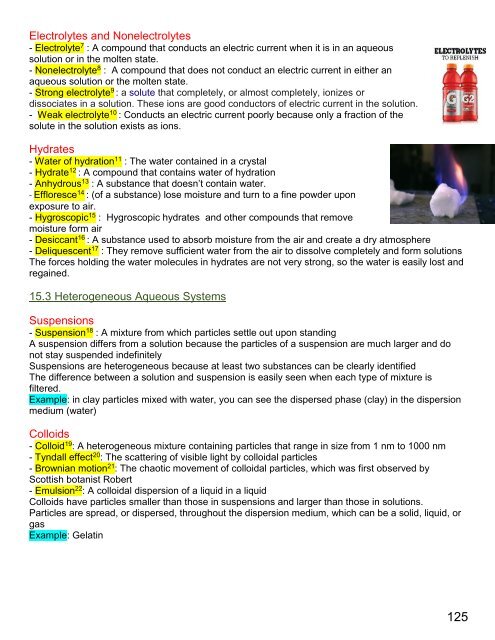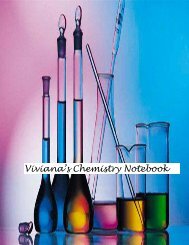Create successful ePaper yourself
Turn your PDF publications into a flip-book with our unique Google optimized e-Paper software.
Electrolytes and Nonelectrolytes<br />
- Electrolyte 7 : A compound that conducts an electric current when it is in an aqueous<br />
solution or in the molten state.<br />
- Nonelectrolyte 8 : A compound that does not conduct an electric current in either an<br />
aqueous solution or the molten state.<br />
- Strong electrolyte 9 : a solute that completely, or almost completely, ionizes or<br />
dissociates in a solution. These ions are good conductors of electric current in the solution.<br />
- Weak electrolyte 10 : Conducts an electric current poorly because only a fraction of the<br />
solute in the solution exists as ions.<br />
Hydrates<br />
- Water of hydration 11 : The water contained in a crystal<br />
- Hydrate 12 : A compound that contains water of hydration<br />
- Anhydrous 13 : A substance that doesn’t contain water.<br />
- Effloresce 14 : (of a substance) lose moisture and turn to a fine powder upon<br />
exposure to air.<br />
- Hygroscopic 15 : Hygroscopic hydrates and other compounds that remove<br />
moisture form air<br />
- Desiccant 16 : A substance used to absorb moisture from the air and create a dry atmosphere<br />
- Deliquescent 17 : They remove sufficient water from the air to dissolve completely and form solutions<br />
The forces holding the water molecules in hydrates are not very strong, so the water is easily lost and<br />
regained.<br />
15.3 Heterogeneous Aqueous Systems<br />
Suspensions<br />
- Suspension 18 : A mixture from which particles settle out upon standing<br />
A suspension differs from a solution because the particles of a suspension are much larger and do<br />
not stay suspended indefinitely<br />
Suspensions are heterogeneous because at least two substances can be clearly identified<br />
The difference between a solution and suspension is easily seen when each type of mixture is<br />
filtered.<br />
Example: in clay particles mixed with water, you can see the dispersed phase (clay) in the dispersion<br />
medium (water)<br />
Colloids<br />
- Colloid 19 : A heterogeneous mixture containing particles that range in size from 1 nm to 1000 nm<br />
- Tyndall effect 20 : The scattering of visible light by colloidal particles<br />
- Brownian motion 21 : The chaotic movement of colloidal particles, which was first observed by<br />
Scottish botanist Robert<br />
- Emulsion 22 : A colloidal dispersion of a liquid in a liquid<br />
Colloids have particles smaller than those in suspensions and larger than those in solutions.<br />
Particles are spread, or dispersed, throughout the dispersion medium, which can be a solid, liquid, or<br />
gas<br />
Example: Gelatin<br />
125




